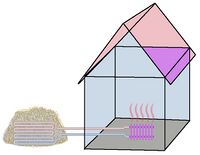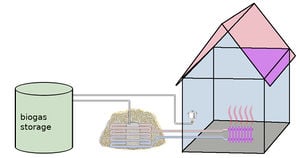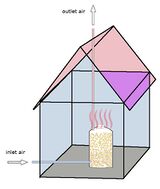(→Calculations: resulting heat from 2000 liters) |
(introduction extended) |
||
| Line 1: | Line 1: | ||
{{Lang|[[Kompostheizung|Deutsch]] - [[Compost heater|English]]}} | {{Lang|[[Kompostheizung|Deutsch]] - [[Compost heater|English]]}} | ||
The '''compost heater''' (also '''Biomeiler''') it a setup for utilization of the [[heat]] dissipation of a [[composting]] process. The thermal effect is well known from a compost heap, where the [[biomass]] is decayed by the digestion and metabolism of many different [[microbes]] and invertebrates. The heat is used, for instance, for a dwelling house. In contrast to the production of [[biogas]], the composting process requires enough [[oxygen]], resulting in an aerobic decay. | The '''compost heater''' (also '''Biomeiler''') it a setup for utilization of the [[heat]] dissipation of a [[composting]] process. The thermal effect is well known from a compost heap, where the [[biomass]] is decayed by the digestion and metabolism of many different [[microbes]] and invertebrates. The heat is used, for instance, for a dwelling house. | ||
In contrast to the production of [[biogas]], the composting process requires enough [[oxygen]], resulting in an aerobic decay. Also, water is added at the beginning to optimize the biological conditions. When the decay has started, additional water is created by the decay process itself, so the compost remains wet indefinitely. Finally, the whole biomass breaks down completely to CO2 and H2O, producing heat. However, the composting process is usually stopped at the end of winter, and the created humus is removed from the heater and used for the garden. | |||
The french agronomist [[Jean Pain]] is held responsible for the invention of the Biomeiler. His system was a combination of a sealed biogas reactor in the center of a big compost heap, producing both biogas and heat. He also worked on agricultural principles in harmony with nature. | The french agronomist [[Jean Pain]] is held responsible for the invention of the Biomeiler. His system was a combination of a sealed biogas reactor in the center of a big compost heap, producing both biogas and heat. He also worked on agricultural principles in harmony with nature. | ||
Revision as of 19:52, 14 September 2019
The compost heater (also Biomeiler) it a setup for utilization of the heat dissipation of a composting process. The thermal effect is well known from a compost heap, where the biomass is decayed by the digestion and metabolism of many different microbes and invertebrates. The heat is used, for instance, for a dwelling house.
In contrast to the production of biogas, the composting process requires enough oxygen, resulting in an aerobic decay. Also, water is added at the beginning to optimize the biological conditions. When the decay has started, additional water is created by the decay process itself, so the compost remains wet indefinitely. Finally, the whole biomass breaks down completely to CO2 and H2O, producing heat. However, the composting process is usually stopped at the end of winter, and the created humus is removed from the heater and used for the garden.
The french agronomist Jean Pain is held responsible for the invention of the Biomeiler. His system was a combination of a sealed biogas reactor in the center of a big compost heap, producing both biogas and heat. He also worked on agricultural principles in harmony with nature.
Three basic types

Compost Heap in the Garden with Water Circulation System
The traditional compost heater exploits the heat of a big compost heap in the garden to warm up a house. This type requires a big compost heap in the Garden, interveined with a spirally water hose. The water circulation conducts the heat to the building, where it can be fed to a heating circuit.
The compost heap must contain at least 8000 liters biomass to be able of holding a temperature during the freezing winter, allowing the thermophilic microbes to continue their work.
Combination of Hot Water and Biogas

The 'Biomeiler' has been invented by Jean Pain. While the idea of using the aerobic process for heating purpose is used in several locations, mostly on demonstration facilities, the combination with biogas, like the original setup of Jean Pain, has not spread much.
Compost Heater Silo inside a Building

The composting process is running in an airtight container inside a house. The produced heat can be distributed by a heating circuit, whereas a simple model of such a compost heater silo does not require a water circulation, radiating the heat directly to the interiors of the house.
Calculations
A considerable amount of biomass (chipped wood, foliage, chopped bush) can be harvested in the garden. The annual energy of about 3860 kWh per 1000 m² is possible. The following data are from energy forestry.
| Data for energy forestry | Values |
|---|---|
| Harvested biomass per 1000 m² | 0.8 to 1.2 metric tons |
| Energy contents of wood* per metric ton | 3860 kWh |
| Energy contents of wood* per stere** | 2100 kWh |
* at 20% residual moisture
** A stere is a simple stack of loose wood in a cubic meter. The actual wood content is about 65 percent, i.e. 1 stere is about 0.65 solid cubic metre of wood.
The unit stere can be used in this context directly to calculate the needed capacity of the compost heater, because the filled in biomass (for example chipped wood) contains a comparable fraction of air. 2100 kWh heat energy are, therefore, generated per m³ composting space. The residual moisture does not diminish the usable energy output and can be ignored in this case. It may vary without any impact. In contrast to a wood stove the residual moisture is not vaporized in a compost heater, so the energy conversion efficiency is not reduced.
While the heating of older dwelling houses require more than 20,000 kWh per year, the recently developed well insulated houses require less than 10000 kWh. For example, the House-in-a-House can be easily served by a compost heater silo of the size 2000 l, which generates 4200 kWh heat, making the interior of the house comfortably warm throughout the year.
Further Information on the Internet
- European bioconversion projects and realizations for macroalgal biomass: Saint-Cast-Le-Guildo (France) experiment, reference to Pain method of breaking down wood chips in relation to the composting of macroalgal biomass
- DIY Water Heating with Compost, article in Mother Earth News (July/August 1981)